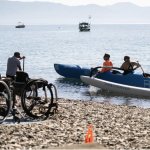County misses recycling goal
Sun News Service

John R. Hart | The Union
Each year, 63,000 tons of garbage get trucked from western Nevada County to a landfill in Yuba County ” an average of 178 tons every day.
Despite several free programs designed to make recycling easier, many residents continue to throw everything away, said Tracey Harper, recycling coordinator for the county.
Half of western county residents who use Waste Management Inc.’s curbside service choose to recycle, Harper said Wednesday.
In 2005, 36 percent of all the household refuse, yard trimmings, construction waste and other discards created in western Nevada County was diverted from landfills, falling behind a state deadline of achieving 50-percent diversion by 2000, Harper said.
That goal was set in 1989 by the California Integrated Waste Management Board.
An extension to meet those levels expired in 2005, and state reviews of 2006 levels won’t be available until March of 2008, Harper said. Indicators show recycling rates in 2006 could improve because overall disposal went down slightly. Local recycling could reach into the range of 40 percent, Harper speculated.
Meanwhile, California legislators are considering raising the required recycling rate to 60 percent by 2012 and 75 percent by 2020.
If the recycling rate doesn’t improve, the state could levy fines on the county of up to $10,000 a day and force the county to impose mandatory recycling.
“It would be a last resort and would be something that would be forced on us from the state,” said Harper.
Steve Porter, county solid waste manager, said he expects the county to get more time to meet those goals after demonstrating good faith efforts, including recycling green waste and re-usable materials from the construction industry.
The county will continue to emphasize education and outreach rather than penalties to convert people to recycling, Porter said.
“I see a time when that could be looked at more closely, but that time isn’t right now,” he said.
More businesses are recycling because it saves them money, Harper said. The construction industry recycled 4,000 tons of building waste last year, while another 4,000 tons went to the landfill.
The county solid waste department is seeking cooperation with apartment and mobile home park owners who, until recently, provided sporadic recycling options to tenants.
Half of western Nevada County residents truck their own trash to the landfill. An average of 400 people per day during the week and up to 700 per day on the weekends haul their own dump loads. Most don’t recycle, even though it is free and means no lines and lowered dump fees, Harper said.
“The county has really invested a lot of resources in programs,” she added. “We kind of scratch our heads … How do we motivate more people to recycle?”
Every day, Bob Elder, operations supervisor at the McCourtney Road transfer station, watches self-haulers throw cardboard, bags of newspapers, plastic bottles, wood and metal into the pit where only nonrecyclable waste is supposed to go.
Elder cited convenience, resistance to change and lack of information for the low recycling rate among self-haulers, even though he hands out a number of informational flyers and the transfer station is set up to recycle almost anything.
“People don’t want to mess with it,” he said.
Reaching a 50-percent recycling rate means a change in mindset, Harper said. The least expensive, most energy efficient way to achieve that goal is to reduce and reuse ” that is, not generate waste in the first place.
“The No. 1 thing people can do is not over-buy,” Harper said ” a tall order in a spend-and-throw-away culture.
“It’s like opening our wallets and throwing dollar bills into the garbage,” she said.
Donating gently used items to thrift stores, using bulk food items, avoiding products with excess packaging and stopping the purchase of junk you don’t need all would help, Harper said.
“Matter doesn’t disappear,” it just gets transported somewhere else, Harper said. “Is that really how we want to use our land and our resources?”
Support Local Journalism


Support Local Journalism
Readers around Lake Tahoe, Truckee, and beyond make the Sierra Sun's work possible. Your financial contribution supports our efforts to deliver quality, locally relevant journalism.
Now more than ever, your support is critical to help us keep our community informed about the evolving coronavirus pandemic and the impact it is having locally. Every contribution, however large or small, will make a difference.
Your donation will help us continue to cover COVID-19 and our other vital local news.









